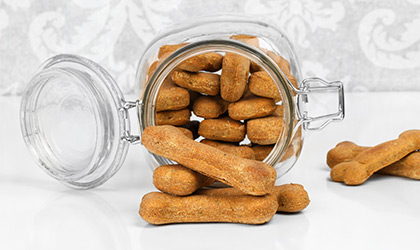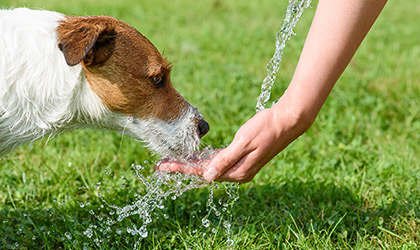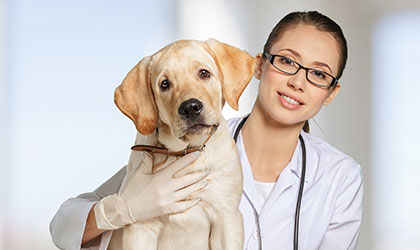
Never before have pet parents had so much choice over what to feed their furry friends. Some light Internet searching on ‘what to feed my pet’ brings up page upon page advocating everything from classic kibble and wet food, to raw, vegetarian and vegan diets. And to confuse matters further, each website or blog claims to have unwavering evidence that their diet is the secret to lifelong health and happiness for our pets. But how much credibility do these new food regimens actually hold? Let’s find out.
Vegetarian and vegan diets
In the pet food industry, trends for pets follow trends for humans. So thanks to veganism and vegetarianism becoming so mainstream, meat-free diets for pets are increasing in popularity too. For many owners, the decision to convert their carnivorous pets to meat-less diets stems from their ethical, environmental and health beliefs. Indeed, most commercial pet foods companies use by-products from factory farms, so transitioning to non-meat diets will avoid supporting the industry. However, feeding your four-pawed companion a vegetarian or vegan diet is a risky and controversial business.
Cats are obligate carnivores, meaning their bodies are designed to run on meat. So, in a way, trying to feed your cat a vegan diet is similar to feeding a horse meat; you’re taking a whole species and forcing it to eat something it isn’t programmed to handle and process. Quite simply, it goes against their physiology. Dogs, on the other hand, are omnivores, which means they can adjust to a carefully planned plant-based diet. But there’s still room for error. And with the wrong application, your pooch could face severe malnourishment.
Unlike us, dogs and cats process certain key nutrients differently. Usually, they’re unable to get all the essential nourishment they need from a plant-based diet alone. For instance, feline and canines can’t absorb vitamin D through their skin – the only way they can receive it is from diet. What’s more, the vitamin D must be D3 (from animal sources), not D2 (from plant-based sources). Both species can also suffer from taurine deficiencies if they don’t receive enough dietary protein.
The risks of feeding cats and dogs non-meat diets could lead to serious – even irreversible – health conditions. They include:
-
Deficiencies in mineral and vitamins (B vitamins, iron, phosphorus, and calcium), which are obtained from animal-based products
-
Inadequate protein intake (less than 25 grams per 1,000 calories)
-
Imbalance of key amino acids such as L-carnitine and taurine (cats and dogs), or essential fatty acids (cats only)
Feeding your furry friend a non-meat diet isn’t something you should jump into lightly. However, if you’re set on the idea, here are some guidelines you must follow:
-
Never feed puppies or kittens non-meat diets
-
Only purchase commercial vegetarian and vegan food that has passed feeding trials
-
Consult your vet to analyse if your meat-free diet is meeting your pet’s needs
-
Begin supplementing your pet’s diet with a high strength omega 3 and multivitamin
-
Increase the number of check-ups your pet has with the vet every year
Yet, in truth, meat-free diets could do more harm than good to your four-pawed friends. Cats and dogs are designed to eat meat: fact. They need animal-based products to nourish their bodies and live optimally. If, however, you do feel passionate about feeding your pet a vegetarian and vegan diet, always liaise closely with your vet. Better still, why not consider getting a species more appropriate for a meat-free diet? A rabbit or goat, for instance, could live very comfortably on a vegan diet!
Raw food diet
Just like the meat-free craze, raw pet food diets are equally in vogue. The raw food diet emphasises feeding cats and dogs raw bones, muscle meat, organ meat (liver and kidneys), raw eggs, fruit (apples) and vegetables (broccoli, spinach and celery). Proponents of the idea concede pets would be healthier if they ate a similar diet to that which they would’ve eaten prior to domestication, rather than commercialised, grain-based pet food. Some experts believe it the way of eating can lead to shiner coats, higher energy, smaller stools and cleaner teeth, arguing it much more beneficial than processed foods.
However, many mainstream vets feel the negatives of the raw food diet outweigh the positives. You see, feeding your furry friend in this way does, admittedly, carry huge risks. Aside from pets potentially choking on whole bones, it can be hard to strike the correct nutritional balance. If pet parents aren’t able to figure out the correct amounts of each food group, animals could face malnutrition and even anaemia. It’s also possible the raw food diet could lack enough phosphorus and calcium, which may lead to dental problems and bone fractures. Worse still, raw meat diets rich in too much vitamin A could lead to toxicity over an extended period of time. Getting nutritional quantities right isn’t the only concern though; thanks to the bacteria present in raw meat, both humans and animals could be at risk of contamination too. In a 2006 study of 20 commercially available raw meat diets, 59.6% were found to contain E.coli bacteria.
If you want to feed your little fur ball a raw food diet, it’s crucial to educate yourself before getting started. Here are some guidelines you must follow:
-
Never fed puppies, kittens, or pets with cancer or other immunosuppressive diseases the raw food diet
-
Speak to your vet before embarking on the raw food diet
-
Always switch from commercial foods to the raw food diet gradually
-
Ensure all raw food is human-grade and frozen fresh
-
Place all thawed raw foods in the fridge and feed your pet within 48 hours
-
Supplement your pet’s diet with a high strength multivitamin and omega 3
-
Wash all surfaces and hands thoroughly after handling raw meat
-
Monitor your pet’s urine, thirst, appetite and energy level, before, during and after the switch to raw
-
See your vet if you suspect illness of any kind
-
Wait one month after switching to this diet before giving your pet raw bones
-
Always monitor your furry friend when they eat whole bones
The veterinary community hasn’t reached a general consensus on the raw food diet debate yet. But, it’s worth pointing out that many owners opt for this diet based on scare tactics and online myths about commercial pet food, as explained in a study published by the Journal of American Veterinary Association (2001). If this is the case, and you want to avoid commercial pet food altogether, why not cook your own homemade food? This will eliminate the potential risk that comes with handling food, and will prevent the possibility of your pet choking on bones.
Take home message
Sometimes what we think is best for our pet isn’t always true. The bottom line is that we simply can’t put our own politics before the nutritional needs of our four-pawed companions. While a meat-free diet may sound appealing to some owners, the unshakeable fact is that our canine and feline friends need to eat meat. Though dogs could survive on a meat-free diet, there are still huge risks involved. And you must ask yourself if you’re prepared to take those on. As for the raw food diet, you need to decide if you can fully commit to it: do you actually have the time to establish a food regimen that ensures your pet receives all the nutrients he needs to live optimally? Always consult your vet first if you’re serious about putting your little fur balls on either diet.
Don’t forget, our supermarket shelves are stacked with high quality commercial kibble and canned food – the only proviso is you need to become an ingredient sleuth. If the label contains the phrase ‘complete and balanced’, then it will meet all your pet’s nutritional needs. Always choose products enriched with healthy levels of essential fatty acids, along with other nourishing nutrients like vitamin A, biotin, vitamin E and zinc. Adding a high-strength multi and omega 3 supplement to your pet’s diet will help you achieve peace of mind.
References:
-
Pet Wed MD . (2018). Should your pet go on a vegetarian diet? Available online: https://pets.webmd.com/features/vegetarian-diet-dogs-cats#3
-
Pet Web MD. (2012). Raw dog food: dietary concern, benefits and risks. Available online: https://pets.webmd.com/dogs/guide/raw-dog-food-dietary-concerns-benefits-and-risks#1



